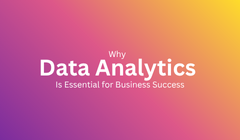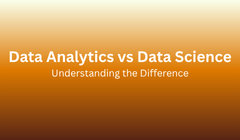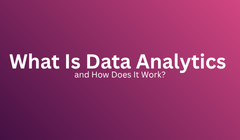
In today’s fast-paced digital world, businesses generate massive volumes of data from customer interactions and online transactions to supply chain operations. However, having data isn’t enough; understanding it is what creates value. Without insight, data remains just noise.
That’s where data analytics steps in. It transforms raw information into actionable intelligence, enabling companies to make smarter, faster, and more confident decisions. Whether it’s a startup finding its first customers or a global enterprise optimizing millions in operations, data analytics is now the backbone of business success.
This blog explores what data analytics is, why it matters, its benefits, how it works, key tools, challenges, and what the future holds.
Data analytics is the process of collecting, cleaning, analyzing, and visualizing data to uncover patterns, correlations, and trends that guide decision-making. It turns complex information into clear insights that drive results.
Examples:
E-commerce platforms identify which products perform best.
Banks detect fraudulent activities through transaction analysis.
Restaurants forecast demand for upcoming seasons.
In essence, analytics converts uncertainty into strategy.
Data analytics is no longer optional it’s essential. According to McKinsey, data-driven organizations are 23x more likely to acquire customers, 6x more likely to retain them, and 19x more likely to be profitable.
It bridges the gap between intuition and intelligence, helping leaders make evidence-based decisions that align with real-world data.
| Type | Purpose | Example |
|---|---|---|
| Descriptive Analytics | Understand what happened | Monthly revenue reports |
| Diagnostic Analytics | Understand why it happened | Analyzing a sales drop |
| Predictive Analytics | Forecast future outcomes | Predicting next quarter’s demand |
| Prescriptive Analytics | Recommend next actions | Suggesting pricing or inventory adjustments |
Together, these approaches help organizations manage the past, present, and future with confidence.
Step 1: Data Collection
Data comes from websites, CRMs, IoT devices, and social media platforms.
Example: A retailer tracks customer demographics, browsing patterns, and purchase behavior.
Step 2: Data Cleaning
Remove errors, duplicates, and inconsistencies to ensure accuracy.
Tools: Excel, Python (Pandas), Trifacta.
Step 3: Data Analysis
Apply statistical and machine learning models to find insights.
Example: Telecom companies use analytics to predict customer churn.
Step 4: Data Visualization
Present insights using dashboards and charts.
Tools: Power BI, Tableau, Google Data Studio.
Step 5: Decision-Making
Use findings to drive strategies like launching new products or optimizing operations.
Analytics provides evidence, not assumptions.
Example: A retailer identifies that ₹499 price points outperform ₹520, boosting sales by 40%.
Understand customer behavior to deliver personalized products and services.
Example: Netflix’s recommendation system, powered by analytics, influences over 80% of viewing activity.
Measure campaign effectiveness and reallocate budgets toward high-performing channels.
Detect inefficiencies and optimize processes.
Example: UPS saves millions annually through route optimization analytics.
Predict potential risks and detect fraud before it happens.
Identify unmet needs and design new offerings.
Data-driven companies act faster and smarter, staying ahead in changing markets.
Retail & E-commerce: Dynamic pricing, personalized recommendations.
Finance: Fraud detection, credit risk modeling.
Healthcare: Predictive treatment, resource allocation.
Manufacturing: Predictive maintenance, supply chain optimization.
Marketing: Campaign tracking, customer journey mapping.
Education: Student performance prediction, personalized learning.
| Category | Tools | Purpose |
|---|---|---|
| Visualization | Tableau, Power BI, Looker | Dashboards and reports |
| Data Management | SQL, BigQuery, AWS Redshift | Query and store data |
| Programming | Python, R | Advanced analytics and automation |
| Big Data | Hadoop, Spark | Large-scale data processing |
| BI Platforms | QlikView, Zoho Analytics | Enterprise intelligence |
These tools democratize analytics, empowering both technical and business teams to draw insights.
Analytics impacts every performance layer:
Sales: Identify high-value products and segments.
Marketing: Optimize ad campaigns for conversions.
Customer Retention: Predict churn and create loyalty programs.
Operations: Streamline workflows and reduce waste.
Productivity: Track and enhance employee performance.
When analytics becomes part of the company culture, growth becomes data-driven and sustainable.
Data Silos: Fragmented data across departments.
Data Quality: Incomplete or inconsistent data affects reliability.
Skill Gaps: Shortage of trained analysts and engineers.
Compliance & Security: Safeguarding sensitive data is critical.
Cultural Resistance: Some teams still depend on instinct over evidence.
The solution lies in leadership commitment, staff training, and strong data governance.
The next decade will see analytics merge with artificial intelligence to deliver real-time, predictive, and automated insights.
Emerging Trends:
AI-driven analytics and AutoML
Real-time data streaming for instant action
Natural language queries for non-technical users
Data democratization across all departments
By 2030, nearly every business process will be data-enhanced and insight-powered.
Challenge: Improve customer experience and optimize store locations.
Solution: Starbucks analyzed demographic and behavioral data to select new store sites and tailor loyalty offers.
Results:
Better location planning
Higher customer retention
Increased sales via personalized campaigns
To unlock analytics’ full potential, organizations must embed it in their DNA:
Leadership must endorse analytics adoption.
Make data accessible through shared dashboards.
Upskill employees in data interpretation.
Align analytics KPIs with business goals.
Continuously monitor outcomes and refine strategies.
A true data culture empowers everyone to make informed, agile decisions.
In the digital era, data analytics is not optional it’s essential. It transforms data into insight, insight into action, and action into success.
Organizations that adopt analytics:
Make smarter decisions
Deliver personalized experiences
Boost efficiency and profitability
Maintain long-term competitiveness
Data is now the most valuable business asset and those who harness it effectively will lead the future.
To build your foundation in analytics, explore What Is Data Analytics and How Does It Work?, and if you want to advance further, read Data Analytics vs Data Science: Understanding the Difference to plan your career path strategically.
“Data will talk to you if you’re willing to listen.” - Jim Bergeson

In today’s data-driven world, organizations thrive on insights extracted from massive datasets. Two major disciplines Data Analytics and Data Science are at the heart of this revolution. While they are closely related, they serve distinct purposes.
If you’ve ever wondered whether Data Science is just a more advanced version of Data Analytics or which path suits your career goals, this comprehensive guide will help you decide.
We’ll explore definitions, workflows, skills, tools, career paths, and future trends of both fieldsso you can make an informed choice.
Every modern business decision, from pricing strategy to customer engagement, depends on data. IDC projects that global data creation will surpass 180 zettabytes by 2025, making analytics and data science critical.
Data Analytics focuses on interpreting existing data to understand “what happened” and “why.”
Data Science builds models and algorithms to predict “what will happen next” and automate outcomes.
Together, they form the foundation of intelligent, data-driven decision-making.
Data Analytics involves examining raw data to uncover meaningful insights, trends, and patterns that guide strategic decisions.
It answers:
What happened?
Why did it happen?
What can we improve?
Key Functions:
Data cleaning and preparation
Statistical analysis
Data visualization and reporting
Business performance tracking
Optimization and decision support
Example:
An e-commerce company analyzes quarterly sales data to discover that low mobile responsiveness caused a revenue dip.
Data Science is a multidisciplinary field that combines data analysis, machine learning, and artificial intelligence to generate predictions and automate complex decisions.
It goes beyond analysis it builds systems that learn from data.
Data Science = Data Analytics + Machine Learning + AI
Key Functions:
Predictive and prescriptive modeling
Algorithm and automation development
Big data processing and cloud integration
AI-powered innovation
Example:
Netflix uses data science to forecast viewer preferences and personalize content recommendations.
| Aspect | Data Analytics | Data Science |
|---|---|---|
| Purpose | Analyzes existing data for insights | Builds predictive and automated systems |
| Focus | Descriptive & Diagnostic | Predictive & Prescriptive |
| Data Type | Mostly structured | Structured + Unstructured |
| Techniques | Regression, Visualization | Machine Learning, Deep Learning |
| Tools | Excel, SQL, Power BI, Tableau | Python, R, TensorFlow, Spark |
| Output | Dashboards, Reports | Predictive Models, AI Systems |
| Complexity | Moderate | High |
| Users | Business teams, analysts | Data scientists, engineers |
In short: Data Analytics explains the past, while Data Science predicts the future.
Data Collection: Gather data from sources like CRM systems or databases.
Data Cleaning: Remove duplicates and handle missing values.
Analysis: Apply statistical techniques for insight generation.
Visualization: Build dashboards for clarity.
Decision-Making: Translate insights into business strategies.
Tools: Power BI, Tableau, SQL, Excel.
Data Acquisition: Extract structured and unstructured data.
Data Wrangling: Clean and transform data for modeling.
Exploratory Data Analysis (EDA): Identify relationships and patterns.
Model Building: Train ML models for prediction.
Model Evaluation: Test and fine-tune model accuracy.
Deployment: Integrate models into business systems.
Tools: Python, R, TensorFlow, Spark, Jupyter Notebook.
| Skill Area | Data Analytics | Data Science |
|---|---|---|
| Programming | Basic Python, SQL | Advanced Python, R |
| Mathematics | Basic statistics | Linear algebra, probability |
| Visualization | Tableau, Power BI | Matplotlib, Seaborn |
| Machine Learning | Optional | Essential |
| Databases | SQL | SQL, NoSQL, Hadoop |
| Cloud Platforms | AWS (basic), Azure BI | AWS ML, Azure ML Studio |
| AI/Deep Learning | Rarely used | Core requirement |
Data Analysts: Often from business, commerce, or IT backgrounds.
Data Scientists: Usually have computer science or mathematics degrees.
Popular Certifications:
Data Analytics: Google Data Analytics, Power BI, Tableau, Python for Analytics.
Data Science: IBM Data Science, TensorFlow Developer, Deep Learning Specialization.
Retail:
Analytics: Identify top-selling products.
Science: Predict customer purchase behavior.
Healthcare:
Analytics: Evaluate hospital readmission rates.
Science: Predict patient outcomes using ML.
Marketing:
Analytics: Measure campaign performance.
Science: Build recommendation engines.
Finance:
Analytics: Analyze fraud patterns.
Science: Automate fraud detection via AI.
Data Analytics Roles:
Data Analyst
Business Analyst
BI Developer
Marketing Analyst
Data Science Roles:
Data Scientist
Machine Learning Engineer
Data Engineer
AI Specialist
| Role | Average Salary (Annual) |
|---|---|
| Data Analyst | ₹6–10 LPA |
| Business Analyst | ₹7–12 LPA |
| Data Scientist | ₹12–25 LPA |
| ML Engineer | ₹14–28 LPA |
| Data Engineer | ₹10–18 LPA |
Both roles rank among India’s most in-demand tech careers.
Choose Data Analytics if you:
Enjoy business strategy and visualization.
Want to enter the data field quickly.
Prefer structured, problem-oriented work.
Choose Data Science if you:
Love programming and math.
Enjoy building intelligent systems.
Want high-growth, AI-driven roles.
Both fields are evolving rapidly with AI integration and automation.
Key Trends:
Augmented Analytics (AI-assisted analysis)
AutoML (Automated Model Training)
Real-Time & Edge Analytics
Natural Language Processing (Conversational AI)
By 2030, the global data and analytics market is expected to exceed $650 billion.
| Parameter | Data Analytics | Data Science |
|---|---|---|
| Goal | Insights from data | Predictive intelligence |
| Focus | Past & Present | Future |
| Data Type | Structured | Structured + Unstructured |
| Complexity | Moderate | Advanced |
| Tools | Power BI, SQL | Python, TensorFlow |
| Output | Reports | Predictive Models |
| Ideal For | Business professionals | Technical innovators |
In most organizations, analysts and scientists collaborate:
Analysts clean and prepare data.
Scientists build models from it.
Engineers deploy these models.
Example:
A bank uses analysts to study churn trends, data scientists to predict who might leave, and business teams to act on those predictions.
Data Analytics Path:
Excel & SQL
Power BI / Tableau
Basic Python & Statistics
Real-world case studies
Data Science Path:
Python or R
Advanced Statistics & Linear Algebra
Machine Learning & AI
Deep Learning and NLP
Capstone projects or Kaggle challenges
Both Data Analytics and Data Science are pillars of the modern data economy.
Analytics interprets data to guide decisions.
Science builds predictive systems that automate them.
If you’re starting out, begin with Data Analytics to master business intelligence and data visualization. Once you’re confident, transition to Data Science for deeper, AI-driven expertise.
For a smooth learning journey, explore What Is Data Analytics and How Does It Work? to strengthen your foundation, then dive into Top 10 Data Science Tools for Beginners to choose the right technologies for growth.
“Data will talk to you if you’re willing to listen.” - Jim Bergeson

In today’s digital world, every click, scroll, and purchase generates data. But raw data alone is meaningless it’s like having uncut diamonds. Data analytics is the process that turns these uncut diamonds into valuable insights. It helps organizations understand trends, forecast outcomes, and make smarter decisions.
This blog explains what data analytics is, how it works, its types, benefits, tools, techniques, and real-world applications. Whether you’re a student, beginner, or professional looking to transition into analytics, this guide provides a complete overview.
Data analytics refers to collecting, organizing, and analyzing data to discover patterns, draw conclusions, and support decision-making. It combines statistical methods, algorithms, and AI-powered tools to transform raw data into actionable insights.
It typically answers four key questions:
What happened? - Descriptive analytics
Why did it happen? - Diagnostic analytics
What will happen next? - Predictive analytics
What should we do about it? - Prescriptive analytics
Together, these layers help businesses understand both past performance and future opportunities.
With global data volumes doubling every two years, analytics has become a necessity for every business.
Key Benefits:
Better decision-making through data-backed insights
Cost optimization and operational efficiency
Enhanced customer experiences through personalization
Improved risk detection and fraud prevention
Innovation driven by hidden trends
Example: Netflix uses data analytics to recommend shows based on your viewing history, boosting engagement and retention.
Data is gathered from multiple sources - websites, mobile apps, social media, sensors, and databases.
Tools: Google Analytics, SQL, AWS S3.
Cleaning ensures data accuracy by removing duplicates, handling missing values, and correcting errors.
Tools: Python (Pandas), Excel, Talend.
This is the core step where statistical models and machine learning are applied to extract insights.
Methods: Descriptive, Predictive, and Prescriptive analysis.
Tools: Python, R, Tableau, Power BI.
Insights are visualized using charts and dashboards for easier interpretation.
Tools: Tableau, Power BI, Google Data Studio.
Insights guide business strategies - from marketing optimization to new product launches.
| Type | Purpose | Example |
|---|---|---|
| Descriptive | Understand what happened | Monthly sales reports |
| Diagnostic | Identify why it happened | Analyzing traffic drop |
| Predictive | Forecast outcomes | Predicting customer churn |
| Prescriptive | Recommend actions | Optimizing marketing spend |
Each stage builds on the previous one, creating a complete data-driven feedback loop.
Structured Data - Organized data (e.g., SQL tables).
Unstructured Data - Text, audio, images, or videos.
Semi-Structured Data - JSON or XML with partial structure.
Example: Combining customer feedback (unstructured) with purchase data (structured) provides deeper insights.
Programming Languages: Python, R, SQL
Visualization Tools: Tableau, Power BI, Google Data Studio
Big Data Platforms: Hadoop, Apache Spark, Google BigQuery
Cloud Tools: AWS Analytics, Azure Synapse, Google Cloud AI Platform
Regression Analysis - Predicting numerical outcomes
Classification & Clustering - Segmenting data
Time Series Analysis - Forecasting future trends
Sentiment Analysis - Understanding emotions in text
Correlation Analysis - Discovering variable relationships
Healthcare: Predict diseases, optimize resources, personalize treatment
Finance: Fraud detection, credit scoring, risk modeling
Marketing: Campaign optimization, customer segmentation
Retail: Inventory management, demand forecasting, pricing optimization
Manufacturing: Predictive maintenance, process automation
Education: Performance analytics, personalized learning
Sports: Player performance tracking and fan engagement
| Feature | Data Analytics | Data Science | Business Intelligence |
|---|---|---|---|
| Purpose | Find insights from existing data | Build predictive models | Create reports & dashboards |
| Focus | Statistics, SQL, Visualization | Machine Learning, AI | KPI tracking, visualization |
| Tools | Excel, Power BI, Tableau | Python, TensorFlow, R | Looker, Power BI |
| Output | Insights | Predictive models | Business reports |
Think of data analytics as the base layer the starting point before progressing into data science or BI.
Poor data quality and incomplete records
Data privacy and compliance risks
Integration issues between platforms
Shortage of skilled professionals
Choosing the right tools and frameworks
Emerging Trends:
AI-driven automation and machine learning
Real-time analytics for instant decision-making
Augmented analytics for non-technical users
Data democratization across teams
Edge analytics for faster IoT insights
By 2030, nearly every business decision will rely on real-time, AI-augmented analytics.
| Role | Description | Average Salary (India) |
|---|---|---|
| Data Analyst | Cleans and interprets data | ₹6–10 LPA |
| Business Analyst | Converts insights to strategy | ₹7–12 LPA |
| Data Engineer | Builds data pipelines | ₹10–18 LPA |
| Data Scientist | Creates predictive models | ₹12–25 LPA |
| BI Developer | Designs dashboards | ₹8–14 LPA |
Learning Path: Excel → SQL → Python → Power BI/Tableau → Machine Learning
Scenario: A clothing retailer wants to boost online sales.
Collect customer behavior data.
Clean and organize datasets.
Analyze purchase trends.
Visualize regional sales in Power BI.
Adjust pricing and promotions.
Result: A 30% increase in sales through targeted marketing.
Data analytics is the backbone of modern decision-making. It converts information into intelligence, enabling smarter businesses and faster innovation.
Whether it’s improving customer satisfaction, optimizing supply chains, or predicting trends, analytics empowers every industry to make better decisions.
As W. Edwards Deming said “Without data, you’re just another person with an opinion.”
If you’re serious about mastering this domain, start with Data Science vs Data Analytics Understanding the Difference, and once ready, check out Top 10 Data Analytics Tools for 2025 to choose the right platform for your projects.